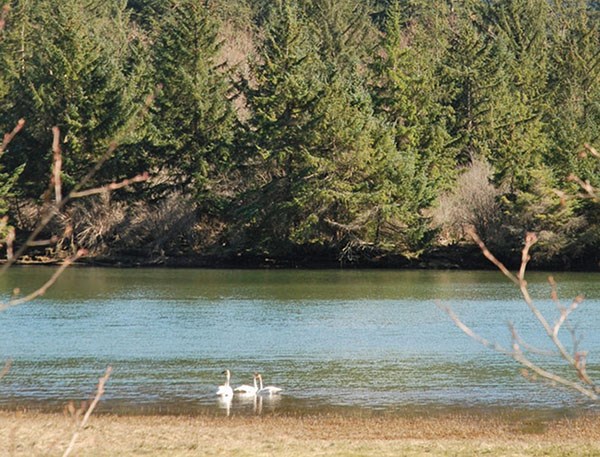A relaxing walk through old-growth forest, Swan Trail is nearly two kilometres leading north out of the central portion of the Squamish Estuary. It runs along the east side of Crescent Slough, an old channel of the Squamish River.
Roots and blind corners will keep you alert to all traffic, which occasionally includes wildlife.
Swan North Trail runs 3.2 kilometres on the top of the river dike from Government Road opposite McNamee Street, past the railway heritage park to the mouth of the Mamquam River. This is a scenic route on a smooth path along the east side of the Squamish River. The recently reclaimed West Barr log sort has been replanted with sedge grass and native shrubs/trees over the past three years. Many volunteer individuals and groups assisted the Squamish River Watershed Society in returning this industrial site to a wilderness habitat.
Birds have been the first to take advantage of this quiet area and small animals are following. Renovations included a modern, well-built trail connecting the estuary loops to Swan Trail. A slough, a pond or marsh alongside the edge of a river where the channels of that river once flowed, is generally filled with mud and provides prime intertidal habitat for amphibian creatures and juvenile fish.
Trumpeter swans settle in
Crescent Slough in the northern part of the estuary is so named because of its shape. This sheltered area is a safe over-wintering site for the endangered trumpeter swan, the largest of waterfowl in North America.
Once paired off, they remain together for life and raise an average of four cygnets each year. The young lose their brownish-grey feathers after one year and remain with their parents for two years.
Trumpeter swans have adapted to urban sites but interference needs to be kept at a minimum especially during the nesting and rearing cycle, which is when they are here in Squamish. Squamish Nation members still recount the story of the “Legend of the Seven Swans.”
About 20 pairs will likely arrive in January and stay until April. Their area is protected as mandated by the CDA/USA Migratory Bird Convention. Being inside the Skwelwil’em Wildlife Management Area, 673 hectares, which is most of the estuary, gives these spectacular birds more protection, but we humans must still be considerate and stay clear.
Look but keep your distance and it is especially important for dogs to be on leash. These Important Birding Areas provide a small degree of protection for species at risk. Those at risk in our area are: Great blue heron, peregrine falcon, marbled murrelet, northern goshawk and western greebe, to name a few.
New life emerging
The central estuary was heavily damaged by dredging for the coal port in the 1970s and various log sort operations over many years. Remediation is almost complete and new life is slowly returning.
The intermixing of fresh and salt water is still not energetic enough to bring back juvenile fish to what once was their rearing area.
Culverts under the Spit road are still not delivering a strong enough flow of fresh water. The DFO, MOE and SRWS monitor this sensitive fish habitat and will take action to continue the revitalization of the Squamish Estuary. The Squamish Estuary Management Committee is tasked to conserve this vital area. Let’s all play a part in protecting this area for future generations.
Swan & Swan North Trails
These two trails combined make for a fine five-kilometre hike from the Squamish Estuary to the mouth of the Mamquam river
Origin of name: Trumpeter swans have wintered in the estuary from December to April for eons.
Trailhead: Kiosk at the north end of the Estuary Loop Trail.
Use: Wide single-track hiking and biking.
Difficulty: Easy green.
Elevation: Sea level to three metres.
Etiquette: Read trailhead notices for usage and guidance. Stay clear of railway tracks.
Feedback: [email protected].




